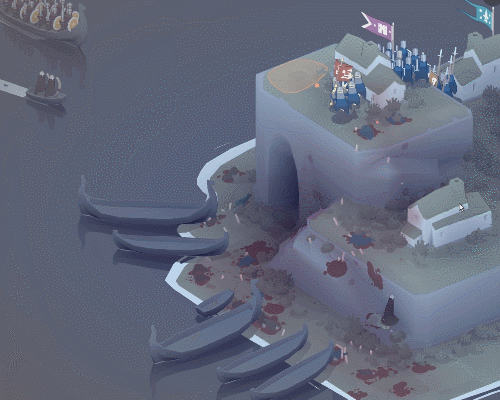Bad North is a real-time strategy game that features adorable vikings and hectic terrain-based combat. It’s the debut game from indie studio Plausible Concept of Sweden, and Raw Fury will publish it this summer on PC, Xbox One, PlayStation 4, Nintendo Switch, and mobile devices.
Though it’s Plausible Concept’s first game, its team has worked on other well-known projects. Founders Oskar Stålberg and Richard Meredith were part of the teams for Tom Clancy’s The Division and Little Nightmares, respectively. The Swedish studio’s sound designer is Martin Kvale, who has received awards for his work on games like Gonner and Hidden Folks. Stålberg does the artwork and some programming, and Meredith is the programmer and handles business development. Both founders have a design role.
At a demo during the Game Developers Conference in San Francisco, Stålberg walked me through the first few levels. The player controls three types of units — infantry, archers, and pikemen. These appear as squads, each of which rallies around a hero that you can upgrade using coins between levels. You can buy the archer hero a longbow, for instance, or give them ability to do a jump attack from higher ground. The main objective is to travel to new islands, fighting off waves of invaders who try to claim the territory for themselves.
The controls aren’t that complex. You click where you want to position your troops, and when they get there, they take care of the rest. Though the battles aren’t turn-based, time slows down during combat so that you can adjust your strategy and make sure you cut off enemies that are trying to get around your defenses.
June 5th: The AI Audit in NYC
Join us next week in NYC to engage with top executive leaders, delving into strategies for auditing AI models to ensure fairness, optimal performance, and ethical compliance across diverse organizations. Secure your attendance for this exclusive invite-only event.
“It’s more about making the right decisions than making them very quickly,” Stålberg said. “We find that a lot of players who, maybe they normally don’t play strategy games, or they used to play strategy games, but these days they’re all too complicated or too fast — they enjoy this game.”
Combat gets hectic quickly. You only have the three squads to work with, and occasionally, you’ll have to take one of them out of commission to heal them up. This leaves them vulnerable to attack, plus different units are effective against different enemies.

“You need to keep track and learn the different moves of the units and how well they cope with different situations, to learn to anticipate them,” said Stålberg. “It can turn really fast. If you miss an archer boat coming in, they can wipe out your pikemen like that.”
So timing is crucial — as is keeping a 360-degree view of the action. The island is a three-dimensional object that you’ll sometimes rotate to check all potential points of attack. If you’re too focused on one shore, you might miss some invaders encroaching on another.
“The shape of the terrain really matters,” said Stålberg. “It creates different choke points and different ways you need to position your units. When there’s more than one at a time, you need to choose which area you want to cover.”
Each island is procedurally generated with different features like hills and embankments. These have strategic importance, but it’s also gorgeous to look at. The entire game has a watercolor look to it, like illustrations from a hand-drawn children’s book. As you play, it cycles from day to night and the seasons change, with flowers sprouting in the spring and mushrooms popping up in the autumn. It gets windy sometimes, which not only affects the trajectory of the arrows but also makes the world feel more alive.
“As you can see, the island is pretty bloody and on fire,” said Stålberg after we successfully fought off the Vikings. “We want to give that feeling of, you won, but it’s still a sad victory. This beautiful home of yours is all bloody now. A pyrrhic victory.”

